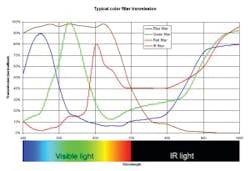How do you assure that you are proposing a video system that will do everything that your customer wants, including recording clear images in all types of light, without running up the cost? Day/night cameras can be a dilemma. When do you propose them and when are they not required? What setting guarantees you get the best image clarity when using them? Are there different variations of day/night cameras on the market? What criteria do most of them meet? What else do you need to propose as complementary products when using day/night cameras? This month, we address all these questions and more as we demystify the technology.
Know the functionalities
Day/night cameras are capable of providing usable images at night by changing camera parameters to work more efficiently in low light. A basic example of day/night operation is the use of infrared (IR) LEDs within the camera housing. Although people can see only visible light, security cameras see both visible and IR light. The addition of artificial IR illumination enhances the ability of the camera to record an image without giving away the camera's presence or field of view.
As security cameras use color filters (blue, green and red) to create a color image, each filter allows IR light to pass through onto the sensor, muddying the colors. Since most lenses are designed for visible light only, most security cameras have an IR filter to block the IR light. This filter improves both the color fidelity and sharpness of the image.
Some lower cost day/night cameras (like those with IR illumination built into the camera housing) generally use software to create the best image they can, given the limitation of allowing both visible and IR illumination through the pixel color filters. At night, the algorithm changes, giving a slight improvement to dark image recording. Changes include desaturating the colors to give the viewer a black and white image.
Technology advances inside cameras have helped aid lighting needs. More sophisticated cameras-those cameras considered true day/night-can physically remove the IR filter from the light path, allowing the camera to see both visible daylight and IR light. This can make the camera 15 to 20 times more sensitive at night compared to a standard day-only camera. These cameras require day/night lenses to keep the scene in focus both day and night. Day/night lenses are generally more expensive because of the added complexity of focusing a broader color spectrum (from visible through IR) onto the sensor. However, show your customer the difference and the price will seem minimal compared to the benefits.
Defining a true day/night camera
A true day/night camera has a movable IR filter. During day performance, the IR filter is in place blocking all the IR light, creating a nice color image. In this case, the IR filter (represented in brown on the chart) will block all IR light greater than about 750 nanometers wavelength. At night, when light decreases, the IR filter is replaced with a clear glass dummy filter. The clear glass allows all available visible and IR light to reach the sensor and be recorded. Nonetheless, there can still be some dark corner images, which are caused by the IR illumination level dropping off as the camera moves farther away from the illumination. Although removing the IR filter improves the light sensitivity, it does so at the expense of color fidelity. To counteract the degraded color in night mode, the software for most day/night cameras desaturates the colors, creating a monochrome image.
How do you know when your customer needs a day/night camera? If there is enough visible light in the scene, a standard camera with IR filter can be used for night security applications. Illumination sources (referenced later in this text) may provide sufficient visible light. As a result, use of a day/night camera in night mode may not be necessary. In this case, the use of a day/night lens is optional. When there is adequate visible light at night, a non-day/night lens can be used with a standard, non-day/night camera. Just make sure that the lens can support the number of megapixels in the camera.
Pick the right lens
A day/night lens may be used on any camera. However, a high quality day/night lens is absolutely required when using a day/night camera. Day/night lenses are designed with the criteria that they focus the infrared light to the same plane as the visible light. This means that the scene is in focus whether using visible light from the sun, moon, or street lights; IR light from these same sources or artificial IR illumination LEDs, or both. Without a day/night lens, the camera would give a soft focus effect at night when both IR and visible light are used at the same time. Integrators also need to understand IR corrected lenses. As mentioned earlier, many natural light sources contain infrared light. However, the amount of light changes as the light source changes over a 24-hour time period. Because wavelengths vary under different types of light (artificial and natural), a non-day/night lens may not be able to focus all the light to the same plane resulting in a condition known as focus shift. This occurs when the camera is focused during the day under natural or visible light (daytime).
But be aware of what happens with the IR blocking filter. This filter is in the optical path during the day to block IR light and maintain good color fidelity. At night, it is moved out of the optical path, allowing the IR light to reach the sensor chip, thus increasing the image brightness but causing colors to get altered. In night mode, when the IR blocking filter is removed, the additional IR light reaching the image sensor may be out of focus or blurred.
An IR corrected lens such as Theia Technologies' SL183 megapixel lens minimizes this light de-focus, which results in a continually focused image during the day and at night. This eliminates the need to re-focus a camera lens at night or when using IR illuminators to provide a light source.
Also be aware of back-focus. Many video cameras come with an automatic back-focus feature that can enable a camera to see a sharp image in IR light without the use of an IR correcting lens. When the camera is operating in night mode, the mechanism automatically moves the sensor to the focal plane for IR light. However, during twilight when there is a combination of visible and IR illumination, the image will not necessarily be in sharp focus. A quality day/night corrected lens is still required to keep the image in good focus with this type of camera.
New lenses on the market even provide day/night performance for megapixel cameras in applications such as parking lots, warehouses, power transformer lots, lobbies, ATMs and other places that need surveillance on a 24/7 basis. Achieving day/night correction with a megapixel quality lens is difficult due to both the increased light spectrum that must be focused at a single plane and the decreased focus spot size required for megapixel cameras.
Illuminate with the right sources
Artificial IR illumination can be provided by IR LEDs. These can enhance the naturally occurring light in the scene. Such lights can be mounted anywhere as long as the IR light can shine on the object that the camera is watching. There is no requirement that the IR lights be mounted at or near the camera. They can be scattered throughout a parking lot, thus bathing the entire area in IR light. However, many visible light sources such as street lights, warehouse lights, incandescent lights, not to mention the sun and moon, are also sources of IR light that can be recorded by the camera's sensor. If the scene has such a light source at night, a day/night camera can record the scene without the aid of additional IR illumination.
Before suggesting a day/night camera as a possible solution for your customer, know its capabilities and the possible applications it may be used in. Which lighting setting is it most efficient in? When is it necessary to use a day/night camera? What type of day/night lens must it complement with? Know what's on the market and be familiar with the solution you offer. Your end-user will thank you for it.
Integrator Tech Tips
Consider the following five points when deciding on a specific model camera for day-time surveillance and which works best for night-time visibility.
1. What is the target scene? What is the distance to the target, what zoom is required, what's the horizontal field, what's the depth of field and what lens type are you using?
2. What is the resolution? What is the number of pixels per foot required at the target distance to obtain usable evidence?
3. What are the lighting conditions? What type of low-light performance (lux rating, @fnn, IRE, AGC) is needed? Will illuminators be required? Are there challenging conditions that will require a wide dynamic range camera?
4. What's the needed frame rate? What frames per second (fps) are required to capture activity for evidence?
5. What's needed regarding the mechanical construction? What IP rating is required? For outdoor use? For indoor use? Vandal resistance? What's the operating temperature range? What form factor-fixed, minidome, Pan, Tilt, Zoom (PTZ)-is needed? What power supply is needed?





